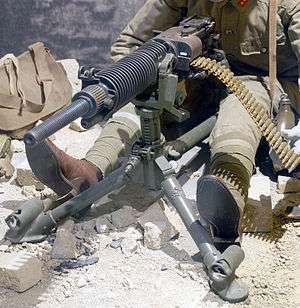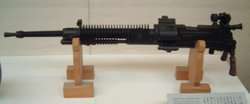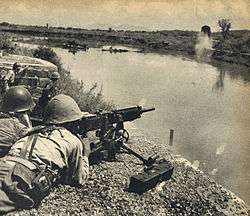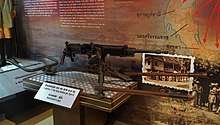Type 92 heavy machine gun
| Type 92 | |
|---|---|
 Type 92 Japanese machine gun | |
| Type | Heavy machine gun |
| Place of origin | Empire of Japan |
| Service history | |
| In service | 1932–50s |
| Used by | See Users |
| Wars |
Second Sino-Japanese War World War II Indonesian National Revolution Korean War Chinese Civil War Vietnam War |
| Production history | |
| Designer | Kijiro Nambu |
| Designed | 1932 |
| Produced | 1932–41 |
| No. built | 45,000 |
| Specifications | |
| Weight | 55.3 kg (122 lb) w/ tripod |
| Length | 1,156 mm (45.5 in) |
| Barrel length | 721 mm (28.4 in) |
|
| |
| Cartridge | 7.7×58 mm Type 92 |
| Caliber | 7.7 mm |
| Action | Gas-operated |
| Rate of fire | 400–450 rounds per min. |
| Muzzle velocity | 800 m/s (2,600 ft/s) |
| Effective firing range | 800 m (870 yd) |
| Feed system | 30-round Hotchkiss-type metal strip |
The Type 92 Heavy Machine Gun (九二式重機関銃 Kyūni-shiki jū-kikanjū) entered service in 1932 and was the standard Japanese heavy machine gun used during World War II. It was used extensively by the Imperial Japanese Army and Collaborationist Chinese forces.[1] Captured weapons were also used extensively by Chinese National Revolutionary Army troops against the Japanese during World War II, the Korean People's Army against the United Nations forces during the Korean War, the Viet Cong and NVA against the United Nations forces during the Vietnam War [1], and the Indonesian Army against the Netherlands Forces during the Indonesian National Revolution. The Type 92 refers to the Japanese Imperial year 2592 – 1932 in the Gregorian calendar – in which the gun entered service.[2] Designed by Kijiro Nambu and built by Hino Motors and Hitachi, total production was about 45,000 guns.[3]
Design
The Type 92 was essentially a scaled-up version of the Type 3 Heavy Machine Gun, with its calibre increased to 7.7 mm, and like the Type 3 was air cooled, ammo strip-fed, and based on the Hotchkiss M1914.[4] It could use both a rimless and semi-rimmed 7.7x58mm Shiki round.[1] A 7.7 mm round could be used if needed or if other ammunition supplies dwindled.[2] Rounds fired from the gun traveled at about 730 m/s (2,400 ft/s), and the rate of fire was about 450 rpm. It was sometimes used as a light anti-aircraft gun during the Pacific War. It was nicknamed "the woodpecker" by Western Allied soldiers because of the characteristic sound it made when fired due to its relatively low rate of fire, and the "chicken neck" (Chinese: 雞脖子) by Chinese soldiers due to its appearance.[1] The Type 92 had a maximum range of 4,500 meters, but a practical range of 800 meters.
The gun was intended to be fired on a tripod with a team of 3 men. The unusual tripod was designed with removable carry poles, so that the weapon could be transported fully assembled for quicker deployment.[2]
An unusual characteristic of this gun was the placement of its iron sights – canted slightly to the right instead of center. A number of different sights were produced for the weapon, the Type 93 and Type 94 periscopic sights as well as the Type 96 telescopic sight. A ring-type anti-aircraft sight was also produced.
Major problems with this weapon included the short feed strips, which did not allow for as high a volume of fire as a belt-fed gun, and the oiler, which enabled better extraction in clean conditions but could bring dirt inside the gun in the field. The gun has an internal oil pump which is mechanically activated by the bolt. The oil pump dispenses a small amount of oil onto a brush, which then lubricates each cartridge as it is fed into the gun.[5]
Users






Gallery
 Type 92 heavy machine gun at the Yasukuni Shrine in Tokyo.
Type 92 heavy machine gun at the Yasukuni Shrine in Tokyo. In use during Battle of Changsha (1941).
In use during Battle of Changsha (1941). Australian soldiers using a captured Type 92 machine gun.
Australian soldiers using a captured Type 92 machine gun. A Japanese soldier aiming at a target through the telescopic sight of his Type 92 heavy machine gun during the Guadalcanal Campaign in 1942.
A Japanese soldier aiming at a target through the telescopic sight of his Type 92 heavy machine gun during the Guadalcanal Campaign in 1942. Type 92 heavy machine gun at the National Memorial in Bangkok.
Type 92 heavy machine gun at the National Memorial in Bangkok. Type 92 machine gun on display at The National WWII Museum in New Orleans.
Type 92 machine gun on display at The National WWII Museum in New Orleans.
References
- 1 2 3 4 5 "Japanese 7.7mm Heavy Machine Gun Type 92". Korean War – Weapons & History. Retrieved 2015-12-11.
- 1 2 3 "Japanese Machine Guns". Nambu World. Retrieved 2015-12-11.
- ↑ "Ground Guns". JapaneseWeapons.net. Retrieved 2015-12-11.
- ↑ Weapons: An International Encyclopedia from 5000 B.C. to 2000 A.D. St. Martin's Press. 1991. ISBN 0-312-03950-6.
- ↑ https://www.youtube.com/watch?v=FgfYvC7LuBY
- ↑ http://www.militaryfactory.com/smallarms/detail.asp?smallarms_id=379
- ↑ Christophe Dutrône (October 2009). "Le salaire de la peur: convois en Indochine". Batailles & Blindés Magazine (in French). No. 33. p. 15. ISSN 1765-0828.
- Daugherty III, Leo J. Fighting Techniques of a Japanese Infantryman 1941–1945. ISBN 1-86227-162-3.
- Nakanishi, Ritta (1998). Japanese Infantry Arms in World War II. Dainipponkaiga.
External links
| Wikimedia Commons has media related to Type 92 machine gun. |
- US Army technical manual TM-E 30–480 at hyperwar
- "Shooting the Japanese Type 92 HMG in Arizona". Rob Rhodes (YouTube). 2009-04-22.